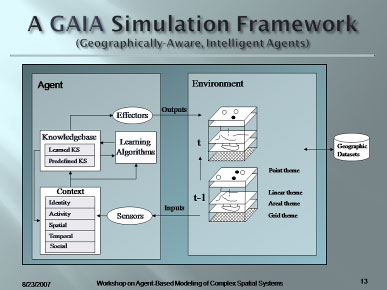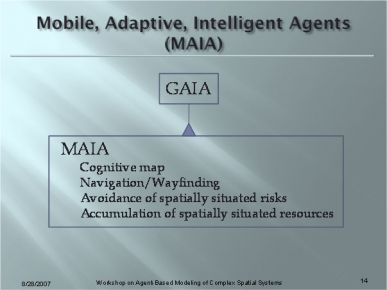College of Liberal Arts & Sciences
GIScience Applied to Human/Environment Interactions
 Biocomplexity across boundaries: What happens when we subdivide highly integrated ecosystems and apply distinctly different management practices to different areas? How do complex landscape-scale processes respond? What impact does it have on the flow of resources across boundaries? These are some of the questions that an interdisciplinary team from multiple institutions hoped to address in this project centered on the northern elk winter range (NEWR) in the Greater Yellowstone ecosystem.
Biocomplexity across boundaries: What happens when we subdivide highly integrated ecosystems and apply distinctly different management practices to different areas? How do complex landscape-scale processes respond? What impact does it have on the flow of resources across boundaries? These are some of the questions that an interdisciplinary team from multiple institutions hoped to address in this project centered on the northern elk winter range (NEWR) in the Greater Yellowstone ecosystem.
Investigators: David Bennett, Wenwu Tang
The NEWR:
When Yellowstone National Park was created in 1872 its northern boundary essentially bisected the winter range of elk (Cervus canadensis). To the north of this boundary the landscape has traditionally been managed as ranchland, and elk were viewed as a negative externality to be minimized by ranchers and a resource to be exploited by hunters and outfitters. South of this border and after 1968, these same elk were considered to part of a self regulating natural ecosystem by park officials. Differences in management objectives north and south of the park boundary created distinct differences in the spatial pattern of risks and resources for elk. These differences may have affected the spatial behavior of elk, causing them to abandon traditional migratory paths that took them out of the park and onto the privately owned landscape of ranchers and hunters during the winter (Lemke 1995).
 Top-down trophic cascades (1):
Top-down trophic cascades (1):
Through much of the 20th century many willow patches along the riparian corridors of YNP were being browsed to just above snow line during the winter by elk. Photographic evidence suggests that this was a distinct change from the early 20th century when willow appear significantly more robust. After around 2000, some of these willows began to grow 3-4 times as high as they did in the mid 1990’s.
One explanation for this phenomenon is the reintroduction of wolves into YNP during the winter of ‘95/96. Since this time the NEWR elk herd has decreased by almost 50%. Fewer elk mean less browsing. While it is likely that wolf predation is having a top-down trophic cascade effect on willow growth (Ripple et al 2001; Fortin et al. 2004), other potential explanations also exist.

Top-down trophic cascades (2):
The work of Vucetich et al. (2005) suggests that the combined effect of drought and human predation is sufficient to explain the post 1995 elk population decline and, thus, the regrowth of willow, and Creel and Winnie (2005) note that wolves may be changing the spatial behavior of elk such that they spend less time in the open valley floor. Finally, land use practices outside of the park are becoming more “elk friendly” at the same time as the wolves are making the park less so. As a result elk have begun to reestablish their migration beyond park boundaries (Lemke, 1998). All of these processes would reduce the winter-time elk herbivory on willow.


Objective:
At the University of Iowa, our main task was to create an agent-based model of elk spatial behavior in and around YNP. To capture the complex and adaptive nature of elk/willow/wolf interaction, we had to build a modeling framework capable of representing:
- Context- information about the environment;
- Cognition– internal representations of external environments and learned stimulus-response relationships;
- Adaptation– learned behaviors that adapt to complex, risky and uncertain environments;
- Cooperation– social processes that allow multipleagents to interact as they attempt to reach common goals;
- Heterogeneity– agent populations that are diverse in terms of their context, knowledge, and adaptive behavior.
The general modeling framework created to support models of spatial decision-making is referred to as GAIA: Geographically-Aware, Intelligents Agents. An extension of GAIA (MAIA– mobile, aware, intelligent agents) was developed to support the simulation of agents that traverse landscapes (e.g., agents that simulate the spatial behavior of elk).
Learning when and where to migrate
From the elk’s perspective, YNP and its surrounding environs can be modeled as two interrelated and dynamic surfaces; a resource surface and a risk surface. “Peaks” in the resource surface (e.g., areas of high winter forage) attract elk, “peaks” in the risk surface repel elk (e.g., areas of high predation by wolves or humans). As elk attempt to survive in this landscape they have to learn how to navigate through these surfaces and adapt to their changing patterns. To simulate the spatial behavior of elk, therefore, we had to model how elk explore, learn, and adapt to changing landscapes. We used machine learning techniques to replicate these behaviors and determine when, where, and how elk migrate through the landscape.
Learning when to migrate: An evolutionary algorithm was developed to evolve a decision table that determine when an elk would initiate a migratory behavior in response to changes in snow depth. The results of the when-to-migrate model are presented below. We see from these graphs that simulated elk behavior changes abruptly as habitat quality drops from 0.7 to 0.6 indicating a sudden and strong migrational response. A habitat quality index of 0.6 suggests that the simulated elk learned to migrate when snow depth exceeded 40cm. These results compare favorably to empirical studies (Sweeney and Sweeney 1984; Turner et al. 1994; Parker et al. 1984).


Learning where to migrate: Reinforcement learning was used to simulate how elk adapt their migration routes in response to changing risks and resources. Results show that learned behavior is impacted by the learning mechanism used and the strength and spatio-temporal variability of the signal; as would be expected. Generally speaking, however, the produced routes were logical and met expectations.

Products
Journal Articles
- Bennett, D.A., and McGinnis, D. accepted. Coupled and Complex: Human-Environment Interaction in the Greater Yellowstone Ecosystem, USA. Geoforum.
- Bennett, D.A., and Tang, W., 2006, Modeling Yellowstone's northern range elk herd as adaptive, spatially aware, and mobile agents. International Journal of Geographical Information Science, 20(9):1039-1066.
- Brown, D.G., Aspinall, R., Bennett, D.A., 2006, Landscape Models and Explanation in Landscape Ecology—A Space for Generative Landscape Science? The Professional Geographer, 58(4):369–382.
- *Tang, W. in review. Development of a Spatially-explicit Agent-based Simulation Package for Modeling Complex Adaptive Geographic Systems. submitted to Cartography and Geographic Information Science .
Book Chapters
- Bennett, D.A. and Tang, W. in press. Mobile Aware Intelligent Agents. In Understanding Dynamics of Geographic Domains, edited by M. Yuan and K. Stewart. CRC Press/Taylor & Francis.
Proceedings
- Bennett, D.A., Tang, W. 2005. Modeling Elk Migration and Trophic Cascades in the Greater Yellowstone Ecosystem: An Agent-based approach. Proceeding of Open Science Conference: Global Change in Mountain Regions, Perth, Scotland.
- Bennett, D.A. and Tang, W. 2005. An agent-based simulation of Yellowstone’s northern range elk herd: a cognitive approach. Proceedings of Geocomputation 2005. Ann Arbor MI.
- Bennett, D.A., 2007. Representation and Interpretation: Challenges for Agent-based Models of Complex Adaptive Spatial Systems. Workshop on Agent-based Modeling of Complex Spatial Systems. Santa Barbara. http://www.ncgia.ucsb.edu/projects/abmcss/.
Presentations
- Invited: Bennett, D.A., 2007. “Representation and Interpretation: Challenges for Agent-based Models of Complex Adaptive Spatial Systems.” Plenary presentation at the Workshop on Agent-based Modeling of Complex Spatial Systems. Santa Barbara.
- International: Bennett, D.A., McGinnis, D.L., and Tang, W., 2006. “The Emergence of Complex Landscape Dynamics.” European Conference on Complex Systems 2006 (ECCS '06): Workshop on Evolution, Emergence, Generation, Oxford, UK.; McGinnis, D.L., Bennett, D.L., 2006. Balance in a Complex Systems-Coupled Natural-Human Systems Around Yellowstone National Park. European Conference on Complex Systems 2006 (ECCS '06): Workshop on Evolution, Emergence, Generation, Oxford, UK.; Bennett, D.A., Tang, W., McGinnis, D. 2005. “Modeling Elk Migration and Trophic Cascades in the Greater Yellowstone Ecosystem: An Agent-based approach.” Open Science Conference on Global Change in Mountain Regions Perth, Scotland, UK.
- National: Bennett, D.A. 2007. Panelist and Organizer (with D. McGinnis) Yellowstone National Park: A system at the intersection of human and environmental dynamics. Annual meeting of the Association of American Geographers. San Francisco, CA.; Tang, W. and Bennett, D.A. 2007. Agent-based modeling of adaptive spatial decision-making in complex geographical systems: a reinforcement learning approach. Annual meeting of the Association of American Geographers. San Francisco, CA.; Bennett, D.A. 2005. Panelist- Biocomplexity on Yellowstone’s Northern Range: Human Impacts and Natural Ecosystems. Eighth Biennial Scientific Conference on the Greater Yellowstone Ecosystem. Mammoth Hot Springs, WY.; Bennett, D.A., and Tang W. 2005. “Modeling Complex Trophic Relations among Elk, Wolves, and Humans in the Greater Yellowstone Ecosystem.” Annual meeting of the Association of American Geographers. Denver, CO.; McGinnis, and D. Bennett. 2005. “Complexity across boundaries - coupled human and natural systems in the Yellowstone Northern Elk Winter Range.” NSF Biocomplexity PI Conference. Washington DC.; Tang, W. and Bennett, D.A. 2005. “Simulating Adaptive Winter Migrational Behaviors of Elk in Northern Yellowstone National Park.” Annual meeting of the Association of American Geographers. Denver, CO.; Bennett, D.A., McGinnis, D.L., Pat ten, D., Shogren, J.F ., Travis, W .R. 2003. "Modeling Yellowstone's Northern Elk Winter Range as a Complex Adaptive System." Annual meeting of the Association of American Geographers. New Orleans, LA.; Huang, L., Bennett, D.A. 2003. "Reinforcement learning agent based model of elk foraging behavior and movement patterns." Annual meeting of the Association of American Geographers. New Orleans, LA.; McGinnis, D.L, Bennett, D.A. 2003. Co-organized and moderated "Biocomplexity and Geographers -How Can Geographers Be Leaders in the NSF Biocomplexity in the Environment Program?" A panel session at the Annual meeting of the Association of American Geographers. New Orleans, LA.
*Received an award for outstanding student paper at the 2007 Summer Assembly of the University Consortium for Geographic Information Science sponsored by the journal Cartography and Geographic Information Science.
Acknowledgements
This work received support from: The National Science Foundation BE-CNH. Award #0216588, Complexity Across Boundaries: Coupled Human and Natural Systems in the Yellowstone Northern Elk Winter Range, The University of Iowa Center for Regional and Global Environmental Research.